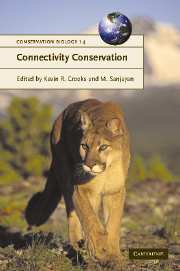Book contents
- Frontmatter
- Contents
- List of contributors
- Acknowledgements
- 1 Connectivity conservation: maintaining connections for nature
- PART I Approaches to connectivity research
- PART II Assessing connectivity
- PART III Challenges and implementation of connectivity conservation
- Introduction: Don't fence me in
- 18 Hyperconnectivity, invasive species, and the breakdown of barriers to dispersal
- 19 Disease and connectivity
- 20 Maintaining and restoring connectivity in landscapes fragmented by roads
- 21 Where to draw the line: integrating feasibility into connectivity planning
- 22 South Coast Missing Linkages: restoring connectivity to wildlands in the largest metropolitan area in the USA
- 23 Incorporating connectivity into broad-scale conservation planning
- 24 Escaping the minimalist trap: design and implementation of large-scale biodiversity corridors
- 25 The role of connectivity in Australian conservation
- 26 The future of connectivity conservation
- Index
- References
Introduction: Don't fence me in
Published online by Cambridge University Press: 24 May 2010
- Frontmatter
- Contents
- List of contributors
- Acknowledgements
- 1 Connectivity conservation: maintaining connections for nature
- PART I Approaches to connectivity research
- PART II Assessing connectivity
- PART III Challenges and implementation of connectivity conservation
- Introduction: Don't fence me in
- 18 Hyperconnectivity, invasive species, and the breakdown of barriers to dispersal
- 19 Disease and connectivity
- 20 Maintaining and restoring connectivity in landscapes fragmented by roads
- 21 Where to draw the line: integrating feasibility into connectivity planning
- 22 South Coast Missing Linkages: restoring connectivity to wildlands in the largest metropolitan area in the USA
- 23 Incorporating connectivity into broad-scale conservation planning
- 24 Escaping the minimalist trap: design and implementation of large-scale biodiversity corridors
- 25 The role of connectivity in Australian conservation
- 26 The future of connectivity conservation
- Index
- References
Summary
Restoring connectivity on an adequate scale quite literally requires turning the concept of nature conservation inside out: from the conventional one of nature surviving in patches (and often in the least desirable parts) of human-dominated landscapes, to one in which human activity is imbedded in a natural matrix. Nothing less can ensure the future of the glorious diversity of life with which we share this planet. It is central to its future on land, in freshwater, and in the seas.
It is clear from this volume that there is much still to be learned about the science of connectivity. It is not an unalloyed “good” thing so that for example it can promote the dispersal of invasive species (Crooks and Suarez Chapter 18) and disease agents (McCallum and Dobson Chapter 19). Yet we do not have the luxury to take a linear approach and study the science of connectivity to a faretheewell before taking the actions to enhance connectivity. Rather science and action must go on in parallel with flexibility to modify in the light of new knowledge.
Consequently, connectivity and making it happen in a heavily modified world – where we neither fully understand the science, the socio-economics, nor the political challenges – becomes central to the conservation and sustainability agenda. Even more than in the past we must be prepared to be bold and try untested approaches, e.g., payment to farmers in lieu of commodity price supports to promote land conservation and connectivity.
- Type
- Chapter
- Information
- Connectivity Conservation , pp. 447 - 450Publisher: Cambridge University PressPrint publication year: 2006



